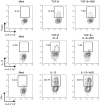1,25-Dihydroxyvitamin D3 inhibits the differentiation and migration of T(H)17 cells to protect against experimental autoimmune encephalomyelitis
- PMID: 20886077
- PMCID: PMC2944871
- DOI: 10.1371/journal.pone.0012925
1,25-Dihydroxyvitamin D3 inhibits the differentiation and migration of T(H)17 cells to protect against experimental autoimmune encephalomyelitis
Erratum in
- PLoS One. 2010;5(12) doi: 10.1371/annotation/6da7b65e-dda2-467d-bcb3-82d5669f6bc6
Abstract
Background: Vitamin D(3), the most physiologically relevant form of vitamin D, is an essential organic compound that has been shown to have a crucial effect on the immune responses. Vitamin D(3) ameliorates the onset of the experimental autoimmune encephalomyelitis (EAE); however, the direct effect of vitamin D(3) on T cells is largely unknown.
Methodology/principal findings: In an in vitro system using cells from mice, the active form of vitamin D(3) (1,25-dihydroxyvitamin D(3)) suppresses both interleukin (IL)-17-producing T cells (T(H)17) and regulatory T cells (Treg) differentiation via a vitamin D receptor signal. The ability of 1,25-dihydroxyvitamin D(3) (1,25(OH)(2)D(3)) to reduce the amount of IL-2 regulates the generation of Treg cells, but not T(H)17 cells. Under T(H)17-polarizing conditions, 1,25(OH)(2)D(3) helps to increase the numbers of IL-10-producing T cells, but 1,25(OH)(2)D(3)'s negative regulation of T(H)17 development is still defined in the IL-10(-/-) T cells. Although the STAT1 signal reciprocally affects the secretion of IL-10 and IL-17, 1,25(OH)(2)D(3) inhibits IL-17 production in STAT1(-/-) T cells. Most interestingly, 1,25(OH)(2)D(3) negatively regulates CCR6 expression which might be essential for T(H)17 cells to enter the central nervous system and initiate EAE.
Conclusions/significance: Our present results in an experimental murine model suggest that 1,25(OH)(2)D(3) can directly regulate T cell differentiation and could be applied in preventive and therapeutic strategies for T(H)17-mediated autoimmune diseases.
Conflict of interest statement
Figures








References
-
- Dong C. Th17 cells in development: an updated view of their molecular identity and genetic programming. Nat Rev Immunol. 2008;8:337–348. - PubMed
-
- Weaver CT, Hatton RD, Mangan PR, Harrington LE. IL-17 family cytokines and the expanding diversity of effector T cell lineages. Annu Rev Immunol. 2007;25:821–852. - PubMed
-
- Noseworthy JH, Lucchinetti C, Rodriguez M, Weinshenker BG. Multiple sclerosis. N Engl J Med. 2000;343:938–952. - PubMed
Publication types
MeSH terms
Substances
LinkOut - more resources
Full Text Sources
Other Literature Sources
Medical
Research Materials
Miscellaneous

